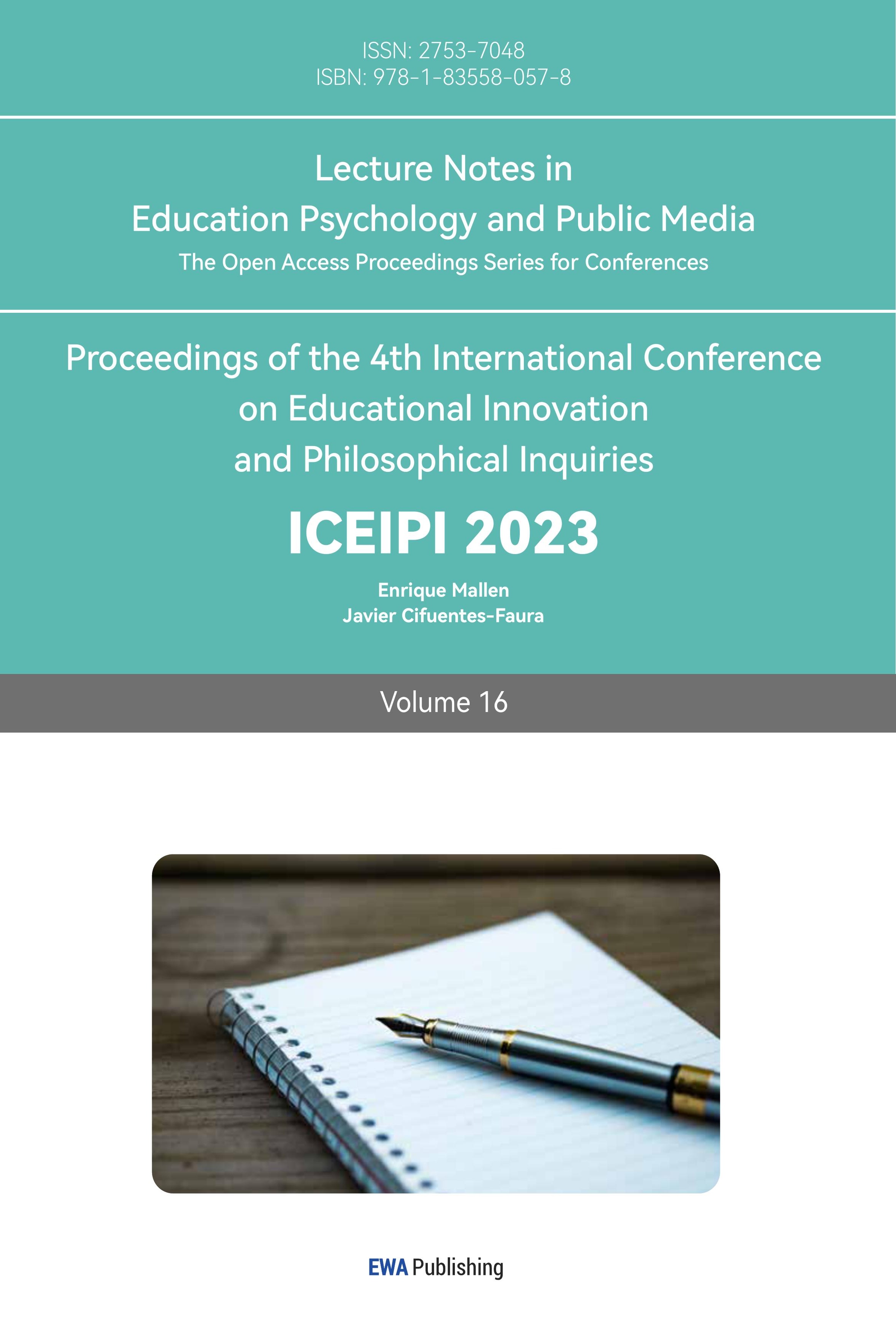References
[1]. Adele, G. (1995). Constructions: A Construction Grammar Approach to Argument Structure. Chicago University Press.
[2]. Chen, M. (2009). The Enlightenment of Construction Grammar Theory to Second Language Teaching. Language Teaching and Research.
[3]. Chen, M. (2009). The Enlightenment of Construction Grammar Theory to Second Language Teaching. Language Teaching and Research.
[4]. Shen, X. (2013). The CAB Model of Chinese ABAC Idiom Constructions. Sichuan International Studies University.
[5]. He, P. (2012). Research on Chinese ABAC four-character pattern under the nonlinear phonological structure. Northeast Normal University.
[6]. Huang, L. (2006). The ABAC Format of Modern Chinese and Its Error Analysis in Second Language Acquisition. Minzu University of China.
[7]. Huang, B., & Liao, X. (2017). Modern Chinese, Gao deng jiao yu chu ban she.
[8]. Zhao, Y., & Bi, J. (1997). The Comparison of Chinese and Foreign Languages and Cultures and the Teaching of Chinese as a Foreign Language. Beijing Language and Culture University Press.
[9]. Cao, D. (2000). Saying “ABAC” construction. Journal of Tai’an Teachers College, 46-49.
[10]. Wang, X., & Marhaba, A. (2020). Application of Construction Theory in Chinese Teaching. University Chinese Construction.
[11]. Wang, J., & Sue, S. (2021). On the Principle of Clustering in the Teaching of Chinese Idioms as a Foreign Language--Taking the “Not X Not Y” Idiom Format to be Embedded as an Example. Journal of Wuyi University, (40).
[12]. Zhang, X. (2019). A Study on the Learning Situation of Chinese Language “ABAC” Format for International Students in Middle and Advanced Levels in Central Asia. Xinjiang University.
Cite this article
Ng,C.Y. (2023). The Features of ABAC Construction and Its Application in Chinese Second Language Teaching. Lecture Notes in Education Psychology and Public Media,16,82-86.
Data availability
The datasets used and/or analyzed during the current study will be available from the authors upon reasonable request.
Disclaimer/Publisher's Note
The statements, opinions and data contained in all publications are solely those of the individual author(s) and contributor(s) and not of EWA Publishing and/or the editor(s). EWA Publishing and/or the editor(s) disclaim responsibility for any injury to people or property resulting from any ideas, methods, instructions or products referred to in the content.
About volume
Volume title: Proceedings of the 4th International Conference on Educational Innovation and Philosophical Inquiries
© 2024 by the author(s). Licensee EWA Publishing, Oxford, UK. This article is an open access article distributed under the terms and
conditions of the Creative Commons Attribution (CC BY) license. Authors who
publish this series agree to the following terms:
1. Authors retain copyright and grant the series right of first publication with the work simultaneously licensed under a Creative Commons
Attribution License that allows others to share the work with an acknowledgment of the work's authorship and initial publication in this
series.
2. Authors are able to enter into separate, additional contractual arrangements for the non-exclusive distribution of the series's published
version of the work (e.g., post it to an institutional repository or publish it in a book), with an acknowledgment of its initial
publication in this series.
3. Authors are permitted and encouraged to post their work online (e.g., in institutional repositories or on their website) prior to and
during the submission process, as it can lead to productive exchanges, as well as earlier and greater citation of published work (See
Open access policy for details).
References
[1]. Adele, G. (1995). Constructions: A Construction Grammar Approach to Argument Structure. Chicago University Press.
[2]. Chen, M. (2009). The Enlightenment of Construction Grammar Theory to Second Language Teaching. Language Teaching and Research.
[3]. Chen, M. (2009). The Enlightenment of Construction Grammar Theory to Second Language Teaching. Language Teaching and Research.
[4]. Shen, X. (2013). The CAB Model of Chinese ABAC Idiom Constructions. Sichuan International Studies University.
[5]. He, P. (2012). Research on Chinese ABAC four-character pattern under the nonlinear phonological structure. Northeast Normal University.
[6]. Huang, L. (2006). The ABAC Format of Modern Chinese and Its Error Analysis in Second Language Acquisition. Minzu University of China.
[7]. Huang, B., & Liao, X. (2017). Modern Chinese, Gao deng jiao yu chu ban she.
[8]. Zhao, Y., & Bi, J. (1997). The Comparison of Chinese and Foreign Languages and Cultures and the Teaching of Chinese as a Foreign Language. Beijing Language and Culture University Press.
[9]. Cao, D. (2000). Saying “ABAC” construction. Journal of Tai’an Teachers College, 46-49.
[10]. Wang, X., & Marhaba, A. (2020). Application of Construction Theory in Chinese Teaching. University Chinese Construction.
[11]. Wang, J., & Sue, S. (2021). On the Principle of Clustering in the Teaching of Chinese Idioms as a Foreign Language--Taking the “Not X Not Y” Idiom Format to be Embedded as an Example. Journal of Wuyi University, (40).
[12]. Zhang, X. (2019). A Study on the Learning Situation of Chinese Language “ABAC” Format for International Students in Middle and Advanced Levels in Central Asia. Xinjiang University.









